
Nastasic/E+ via Getty Images
Do you have the stomach for contrarian investing – betting against the crowd? Sometimes that’s necessary in order to find value. Why buy at a premium when you can buy at a discount?
In the world of closed-end funds, buying funds at deeper than historical discounts to NAV can be a successful strategy over the long run.
We’ve covered many CEF’s in our articles, as they’re useful income vehicles with attractive yields for income investors.
BlackRock Science And Technology Trust (NYSE:BST), and its younger sibling, BlackRock Science and Technology Trust II (BSTZ), which IPOd in 2019, are two popular sister tech funds which cover different aspects of the tech sector.
BST focuses on large caps, while BSTZ favors small caps and more cutting-edge companies. BSTZ also has more exposure to non-US regions:
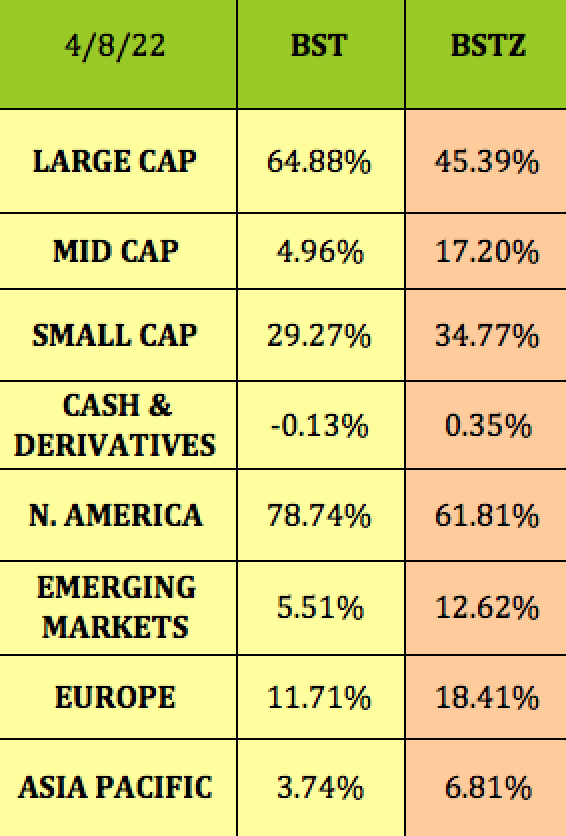
Hidden Dividend Stocks Plus
Both funds have gotten pummeled so far in 2022, with BST down -15.6%, and BSTZ down -25%, also lagging the broad tech sector, and the NASDAQ 100 over the past year, month and quarter:
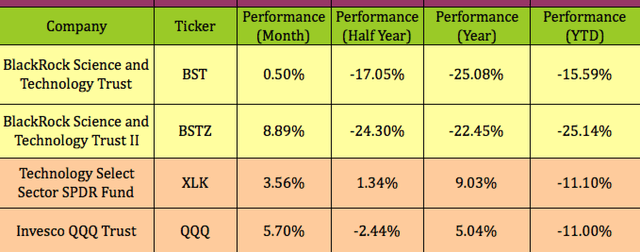
Hidden Dividend Stocks Plus
Profiles:
BST is a perpetual closed-end equity fund. BST commenced operations in October 2014 with the investment objectives of providing income and total return through a combination of current income, current gains and long-term capital appreciation.
Under normal market conditions, the Trust will invest at least 80% of its total assets in equity securities issued by U.S. and non-U.S. science and technology companies in any market capitalization range, selected for their rapid and sustainable growth potential from the development, advancement and use of science and/or technology (high growth science and technology stocks), and/or potential to generate current income from advantageous dividend yields (cyclical science and technology stocks).
As part of its investment strategy, management sells covered call options on a portion of the common stocks in its portfolio. (BST site)
BSTZ is a limited-term closed-end equity fund. BSTZ commenced operations in June 2019 with the investment objectives of providing total return and income through a combination of current income, current gains and long-term capital appreciation. Under normal market conditions, the Trust will invest at least 80% of its total assets in equity securities issued by U.S. and non-U.S. science and technology companies in any market capitalization range, selected for their rapid and sustainable growth potential from the development, advancement and use of science and/or technology. Management sells covered call options on a portion of the common stocks in its portfolio. (BSTZ site)
Both funds share the same management team.
BSTZ is much larger than BST, with $2.4B in net assets, vs. $1.4B for BST. Both funds have had heavier volume in 2022 – BSTZ’s went from 111K in October ’21 to a 251K average currently, while BST’s average volume grew from 125K to 181K. BST has 116 holdings, vs. 109 for BSTZ.
As noted above, both funds sell covered calls – BST had ~25% of its portfolio overwritten, while BSTZ had ~22%, as of 3/31/22:

Hidden Dividend Stocks Plus
Pricing:
With interest rates rising, the tech sector has gotten the cold shoulder from Mr. Market, along with many other sectors. This has pushed tech-oriented CEFs like BST and BSTZ into deeper than historical discounts to NAV/share.
At $41.76, BST had 5.13% discount to its 4/7/22 NAV/share, much deeper than its one-year average discount of -0.90%, its 3-year average premium of 0.69%, and its five-year average premium of .79%.
BSTZ has a discount to NAV/share of -7.91%, deeper than its one-year average discount of -5.48%. BSTZ IPOs in 2019, so there is no three- and five-year discount data available.

Hidden Dividend Stocks Plus
Holdings:
BST held 46.69% in Software & Services as of 3/31/22, down slightly vs. its 48.3% as of 12/31/21. Semiconductors were up a bit, to 21.35%, vs. 18.5% as of 12/31/21.
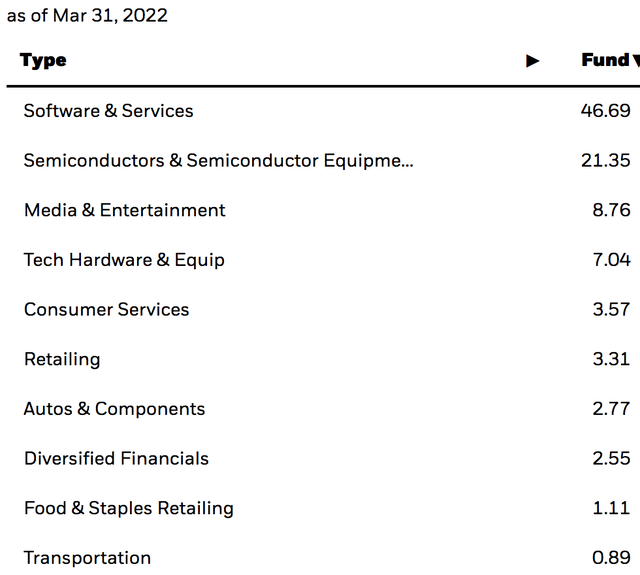
BST site
BSTZ top 3 sector holdings were similar to BST’s, as of 3/31/22, with Semiconductors being a bit heavier, at ~25%, vs. 21.35% for BST:
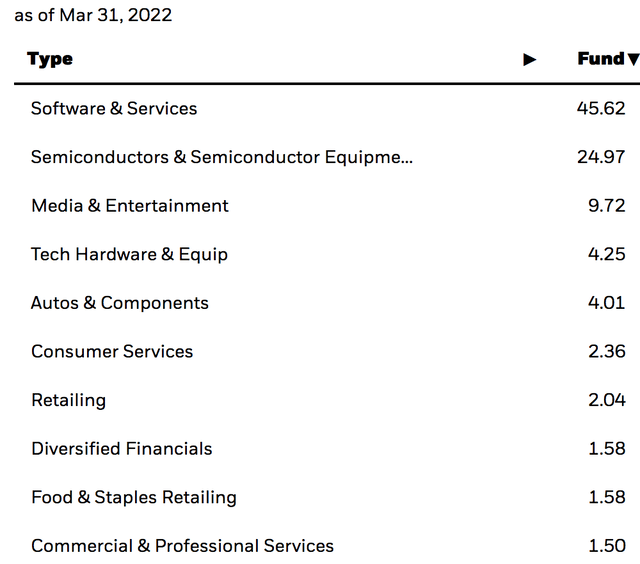
BSTZ site
BST’s top 10 holdings were still mainly well-known US tech large caps, although ASML was replaced by Project Shopping Series E, and LAM Research was replaced by Visa, as of 3/31/22. They comprise ~30% of BST’s portfolio:
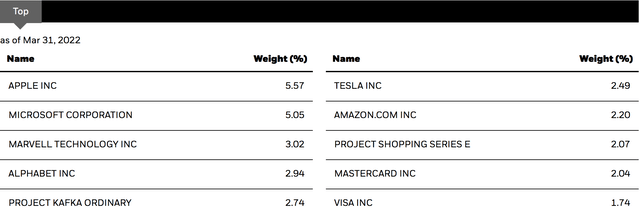
BST site
BSTZ’s top 10 also holds some familiar big cap names, but is more eclectic, with several lesser-known holdings:

BSTZ site
Dividends:
BST’s management raised the regular monthly dividends twice in 2021 – it went from $.1870 to $.2260 in March, and $0.226 to $0.25 in October, a 33.68% rise in 1 year. They also paid out $1.80844/share as a special dividend in late December 2021.
At $41.76, BST yields 7.18%. It will go ex-dividend next on 4/13/22, with a 4/29/22 pay date. It boasts a five-year dividend growth rate of 33.64%.
BSTZ yields 8.04%, and also had two hikes in 2021, from $.1115 to $.1710, to $.1920. It paid a special distribution of $1.2717 in December ’21. It also goes ex-dividend on 4/13/22, with a 4/29/22 pay date.

Hidden Dividend Stocks Plus
BST covered its 2021 distributions by 1.08X factor, via realized gains, while BSTZ had a higher coverage factor of 1.24X, with ~17% of coverage coming from NII, and the balance from realized gains:
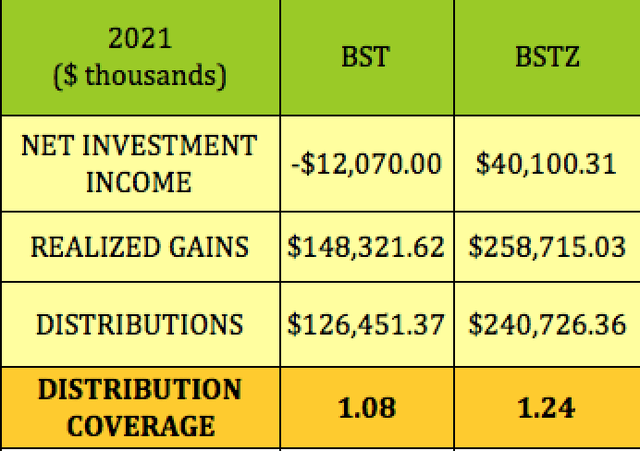
Hidden Dividend Stocks Plus
Taxes:
so far in 2022, BST’s distributions have come entirely from long-term capital gains, while BSTZ’s have come from short-term capital gains.
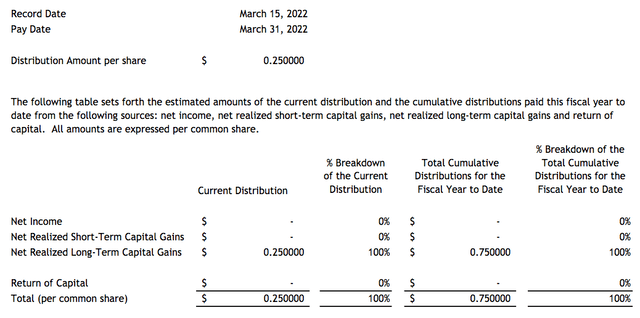
BST site
Long-Term Performance:
BST outperformed its category in 2017 – 2020 on a price and NAV basis, but lagged in 2016 and 2021, and continues to lag in 2022:
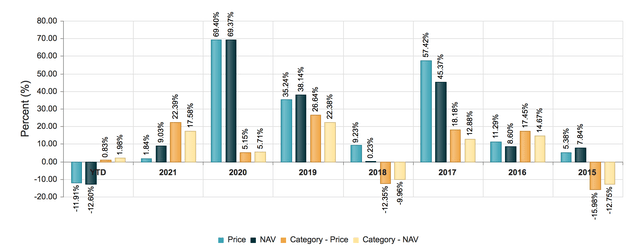
BST site
BSTZ has a much shorter history – it outperformed by a wide margin in 2020, but lagged in 2021, and continues to lag in 2022:

BSTZ site
Parting Thoughts:
When will the tech sector find favor again? It’s down ~-16% so far in 2022 – the worst sector performer. But looking back over the past five years shows BST and the tech sector with a much greater return than the S&P 500:
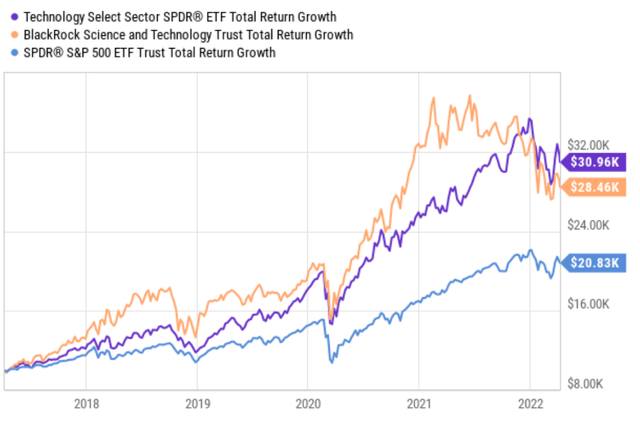
Ycharts
How long will rates rise? No one knows, but eventually the tech sector should find favor again, and reverse its recent downward course. Best of luck trying to time that – brave souls who jump in now will probably have a rough ride for a while, with only the monthly distributions for protection.
However, at some point, they should be vindicated. Contrarian investing often depends on how long you can hang in there. Just remember the old adage, “the market can stay irrational longer than you can stay solvent.”
All tables by Hidden Dividend Stocks Plus, except where otherwise noted.


Be the first to comment